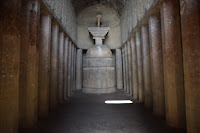Visit to Bedse Caves
Today’s blog is about Bedse Caves, near Lonavala, Mumbai. It is one the Karla Bhaje Bedse caves complex. It is the smallest of the three, and he best preserved and yet lesser know.
 Once you reach at the base, look up at the mountains and you can spot a Plumeria or Champa tree. Sight at it is the best when it is fully bloomed. The caves are right there and you can see it from the base. The climb is eased by well built stairs, with no less than 455 steps. Happy climbing, folks! Around a 15-20 minute climb, you enter a big verandah and an awesome view when you look down, again best viewed when the surroundings are all green and clear morning sunlight is there. To the left, there is small mound like structure, a stupa, and a small room where I guess the work was under progress and then abandoned. I’m not sure about it. Now, Let’s take a round. There are potable water storage pits and this might have been dug when caves were being carved. There is some inscription above it which I guess means water pit.
Once you reach at the base, look up at the mountains and you can spot a Plumeria or Champa tree. Sight at it is the best when it is fully bloomed. The caves are right there and you can see it from the base. The climb is eased by well built stairs, with no less than 455 steps. Happy climbing, folks! Around a 15-20 minute climb, you enter a big verandah and an awesome view when you look down, again best viewed when the surroundings are all green and clear morning sunlight is there. To the left, there is small mound like structure, a stupa, and a small room where I guess the work was under progress and then abandoned. I’m not sure about it. Now, Let’s take a round. There are potable water storage pits and this might have been dug when caves were being carved. There is some inscription above it which I guess means water pit. The entrance to the main chaityagriha or prayer hall is narrow. The pillars in the entrance have sculptures depicting horses, riders and there are beautifully carved repetitive windows and frames. Just outside, to the right, there is small room. The chaityagriha is smaller than those of Karla and Bhaja caves. However, since it faces east, rays of early rising sun entering the foyer makes it a magnificent view.There are 26 pillars inside with designs carves on some of them. I could see this carved design on almost all the stupas. I am not sure if this has any specific meaning. There are small notches on the inside of the walls which I believe served to keep lamps and flambeaus. On the floor just outside the hall, there are small holes. This might have been used for some rituals, I guess.
The entrance to the main chaityagriha or prayer hall is narrow. The pillars in the entrance have sculptures depicting horses, riders and there are beautifully carved repetitive windows and frames. Just outside, to the right, there is small room. The chaityagriha is smaller than those of Karla and Bhaja caves. However, since it faces east, rays of early rising sun entering the foyer makes it a magnificent view.There are 26 pillars inside with designs carves on some of them. I could see this carved design on almost all the stupas. I am not sure if this has any specific meaning. There are small notches on the inside of the walls which I believe served to keep lamps and flambeaus. On the floor just outside the hall, there are small holes. This might have been used for some rituals, I guess.
 After exiting the main prayer hall, there is a way leading to what I assume would have been rooms for monks. There are what I assume to be benches. As you can see, there are simple frames outside the rooms. I could spot some cracks or are these fault lines? A complete tour to the caves takes about 15-20 minutes, however I suggest spending more time and meditating if that is your thing. Smell a few Champa flowers or observe nature and when your heart is filled with serenity, it’s time to get back to our chaotic lives, again.
After exiting the main prayer hall, there is a way leading to what I assume would have been rooms for monks. There are what I assume to be benches. As you can see, there are simple frames outside the rooms. I could spot some cracks or are these fault lines? A complete tour to the caves takes about 15-20 minutes, however I suggest spending more time and meditating if that is your thing. Smell a few Champa flowers or observe nature and when your heart is filled with serenity, it’s time to get back to our chaotic lives, again.
Do let me know how you feel about visiting this place. Subscribe my channel iroguehermit for more videos.
You may watch the video here.













